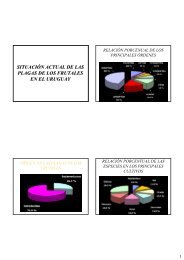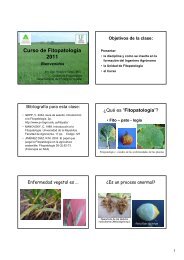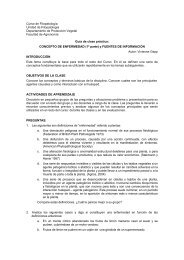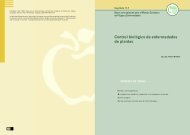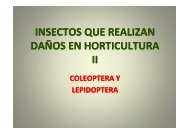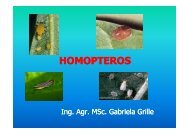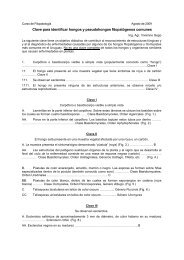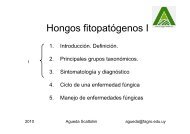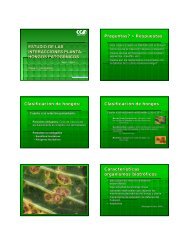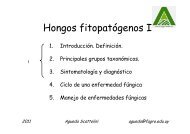Manejo de enfermedades de la lechuga - Facultad de Agronomía
Manejo de enfermedades de la lechuga - Facultad de Agronomía
Manejo de enfermedades de la lechuga - Facultad de Agronomía
Create successful ePaper yourself
Turn your PDF publications into a flip-book with our unique Google optimized e-Paper software.
MANEJO DE ENFERMEDADES<br />
DE LA LECHUGA<br />
(Lactuca sativa)<br />
Ing. Agr. Pablo Héctor González Rabelino MSc.<br />
Características <strong>de</strong>l cultivo<br />
• Época <strong>de</strong> cultivo<br />
• Forma <strong>de</strong> <strong>la</strong> p<strong>la</strong>nta<br />
• Requerimientos<br />
• Ciclo<br />
TUMBADO<br />
Sclerotinia sclerotiorum<br />
Sclerotinia minor<br />
3<br />
5<br />
Limitantes en <strong>la</strong> producción <strong>de</strong><br />
<strong>lechuga</strong> en Montevi<strong>de</strong>o<br />
Enfermeda<strong>de</strong>s<br />
Fuente: Gepp et al., 1998<br />
• Tumbado<br />
• Moho gris<br />
•Mildiu<br />
•Oidio<br />
• Mosaico <strong>de</strong> <strong>la</strong> <strong>lechuga</strong><br />
• Peste negra <strong>de</strong>l tomate<br />
• Quemado <strong>de</strong> los bor<strong>de</strong>s <strong>de</strong> <strong>la</strong>s hojas<br />
Síntomas<br />
2<br />
4<br />
6<br />
1
Ciclo<br />
Humedad en el<br />
suelo, 10-18ºC,<br />
Cielo nub<strong>la</strong>do<br />
Apotecios (%)<br />
Síntomas<br />
Producción <strong>de</strong> apotecios <strong>de</strong> esclerotos <strong>de</strong> Sclerotinia<br />
sclerotiorum a diferente potencial <strong>de</strong> agua y<br />
temperatura<br />
Días<br />
Fuente: C<strong>la</strong>rkson et al., 2004<br />
7<br />
9<br />
11<br />
Micelio y esclerotos <strong>de</strong> Sclerotinia sclerotiorum<br />
Ciclo<br />
Signo<br />
Tumbado<br />
A B<br />
Esclerotos (A) Sclerotinia sclerotiorum (B) S. minor<br />
• Humedad Re<strong>la</strong>tiva > 90%<br />
• Temperatura 16-20 ºC<br />
• Alta humedad en el suelo<br />
• Tejidos senescentes<br />
0,5 - 3 mm<br />
Temp. óptima: 18 ºC (16-24ºC)<br />
Hd suelo: -0,3 bar<br />
8<br />
10<br />
12<br />
2
Medidas <strong>de</strong> manejo<br />
Inci<strong>de</strong>ncia <strong>de</strong>l tumbado vs Cultivo prece<strong>de</strong>nte<br />
Inci<strong>de</strong>ncia (%)<br />
12<br />
10<br />
8<br />
6<br />
4<br />
2<br />
0<br />
Lechuga<br />
Cucurbitáceas,<br />
crucíferas,<br />
tomate, escaro<strong>la</strong><br />
Barbecho corto<br />
Gramíneas,<br />
chenopodiaceas,<br />
cebol<strong>la</strong><br />
Campo natural,<br />
viña, frutales<br />
% S. sclerotiorum % S. minor % Botrytis<br />
Fuente: Gepp et al., 1998<br />
Inci<strong>de</strong>ncia <strong>de</strong>l tumbado vs Eliminar p<strong>la</strong>ntas infectadas<br />
Fecha<br />
1980<br />
1981<br />
1982<br />
Elimina<br />
9,00<br />
3,00<br />
< 0,01<br />
No elimina<br />
20,00<br />
12,00<br />
12,10<br />
13<br />
15<br />
17<br />
Curva <strong>de</strong> progreso <strong>de</strong>l tumbado (Sclerotinia minor) en<br />
cultivo <strong>de</strong> <strong>lechuga</strong> manejadas en diferentes sistemas <strong>de</strong><br />
rotación<br />
% tumbado<br />
Inci<strong>de</strong>ncia <strong>de</strong>l tumbado (%)<br />
14<br />
12<br />
10<br />
8<br />
6<br />
4<br />
2<br />
0<br />
Semanas <strong>de</strong>s<strong>de</strong> el transp<strong>la</strong>nte<br />
B= Brócoli<br />
L= Lechuga<br />
F= Barbecho<br />
Fuente: Hao & Subbarao, 2006<br />
Inci<strong>de</strong>ncia <strong>de</strong>l tumbado vs Malezas<br />
1,43<br />
3,74<br />
8,23<br />
9,83<br />
13,06<br />
1 2 3 4 5 6<br />
Enmalezamiento<br />
Fuente: Gepp et al., 1998<br />
Control físico - So<strong>la</strong>rización<br />
14<br />
16<br />
18<br />
3
Cuchil<strong>la</strong> Gran<strong>de</strong><br />
5 cm<br />
18 cm<br />
Punta Espinillo<br />
5 cm<br />
18 cm<br />
Temperaturas máximas (ºC)<br />
con nylon<br />
55<br />
42<br />
con nylon<br />
57<br />
38<br />
sin nylon<br />
46<br />
38<br />
sin nylon<br />
36<br />
30<br />
Inci<strong>de</strong>ncia <strong>de</strong>l tumbado en p<strong>la</strong>ntas cultivadas en<br />
canteros so<strong>la</strong>rizados<br />
30<br />
25<br />
20<br />
15<br />
10<br />
5<br />
0<br />
a<br />
Cont rol 30 30 days días 45 45 días days<br />
So<strong>la</strong>rización (días)<br />
Medias con <strong>la</strong> misma letra no difieren por el teste Duncan (P
Inci<strong>de</strong>ncia <strong>de</strong> tumbado, número, viabilidad y<br />
mycoparasitismo <strong>de</strong> esclerotos en p<strong>la</strong>ntas tratadas con<br />
Coniothyrium minitans y Rovral<br />
Tratamientos<br />
Control<br />
Rovral (1)<br />
Rovral (2)<br />
C. minitans<br />
C. minitans + Rovral (1)<br />
% P<strong>la</strong>ntas<br />
enfermas<br />
Nº medio <strong>de</strong><br />
escle/ 500 cm 2 <strong>de</strong><br />
suelo<br />
% esclerotos<br />
viables<br />
% esclerotos<br />
infectados por<br />
C. minitans<br />
C1 C2 C3 C1 C2 C3 C1 C2 C3 C1 C2 C3<br />
(1) Una so<strong>la</strong> aplicación cuando se observaba los primeros síntomas<br />
(2) Cada dos semanas<br />
Medias con <strong>la</strong> misma letra no difieren por el teste <strong>de</strong> LSD (P95%),<br />
• agua libre en <strong>la</strong> superficie <strong>de</strong> <strong>la</strong>s p<strong>la</strong>ntas,<br />
•temperaturas amenas (15-25 °C),<br />
• baja intensidad <strong>de</strong> luz<br />
• disponibilidad <strong>de</strong> tejidos senescentes o con heridas<br />
(Hausbeck & Moorman, 1996).<br />
26<br />
28<br />
30<br />
5
Medidas <strong>de</strong> manejo<br />
• Marco <strong>de</strong> p<strong>la</strong>ntación que permita mayor<br />
aireación.<br />
• Evitar exceso <strong>de</strong> riego y <strong>de</strong> fertilización;<br />
• Eliminar y <strong>de</strong>struir restos vegetales<br />
enfermos<br />
Control químico<br />
Principio Activo<br />
Nombre<br />
Comercial<br />
Carencia<br />
(días)<br />
Procimidone (1) Sumisclex 21<br />
Iprodione (1) Rovral 14<br />
Folpet + Procloraz Mirage F 14<br />
Ciprodinil + Fludioxinil Switch 62,5 WG 14<br />
Captan Merpan 7<br />
Pyremethanyl Mythos 3<br />
(1) Máximo dos aplicaciones por ciclo <strong>de</strong> cultivo<br />
31<br />
Períodos <strong>de</strong> riesgo <strong>de</strong> aparición Botrytis<br />
Temperatura (°C)<br />
Humedad<br />
Duración<br />
(horas) 4º 8º 12º 16º 20<br />
4 BAJO BAJO BAJO BAJO BAJO<br />
6 BAJO BAJO BAJO BAJO BAJO<br />
8 BAJO BAJO BAJO BAJO MEDIO<br />
10 BAJO BAJO BAJO BAJO ALTO<br />
13 BAJO BAJO BAJO ALTO ALTO<br />
24 BAJO MEDIO ALTO ALTO ALTO<br />
36 BAJO ALTO ALTO ALTO ALTO<br />
48 MEDIO ALTO ALTO ALTO ALTO<br />
Yarhorough (2007)<br />
32<br />
Fuente: Normas <strong>de</strong> Producción Integrada <strong>de</strong> Lechuga, 2003 33<br />
34<br />
Síntomas<br />
35<br />
Mildiu<br />
Bremia <strong>la</strong>ctucae<br />
Síntomas<br />
36<br />
6
Cultivos vecinos<br />
Rastrojo<br />
Ciclo<br />
18 - 22 ºC<br />
5 - 6 días<br />
Días nub<strong>la</strong>dos<br />
Número <strong>de</strong> esporangios <strong>de</strong> Bremia <strong>la</strong>ctucae sobre<br />
cotiledones <strong>de</strong> <strong>lechuga</strong> incubados a diferente humedad<br />
re<strong>la</strong>tiva, temperatura y tiempo<br />
Número <strong>de</strong> esporangios por cotiledón (x 10 3 )<br />
Cultural<br />
Temp.<br />
Temp.<br />
Horas<br />
Horas<br />
Número <strong>de</strong> esporangios por cotiledón (x 10 3 )<br />
Temp.<br />
Medidas <strong>de</strong> manejo<br />
• Utilizar varieda<strong>de</strong>s resistentes;<br />
• Sistematizar los cuadros <strong>de</strong> forma <strong>de</strong> evitar<br />
acumu<strong>la</strong>ción <strong>de</strong> agua;<br />
• Sembrar a <strong>de</strong>nsida<strong>de</strong>s <strong>de</strong> siembra baja para<br />
favorecer <strong>la</strong> aireación en el cultivo;<br />
• Eliminar y <strong>de</strong>struir restos vegetales enfermos<br />
Horas<br />
Horas<br />
37<br />
Mildiu<br />
• HR 100 %<br />
•18-22 ºC<br />
• Agua libre<br />
• Baja intensidad lumínica<br />
Inci<strong>de</strong>ncia <strong>de</strong> esporu<strong>la</strong>ción en cotiledones incubados<br />
con viento y humedad re<strong>la</strong>tiva<br />
Temp.<br />
Fuente: Su et al., 2004 39<br />
Velocidad<br />
<strong>de</strong>l viento<br />
Fuente: Su et al., 2004 40<br />
41<br />
Cotiledones con esporu<strong>la</strong>ción (%)<br />
Velocidad<br />
<strong>de</strong>l viento<br />
Control químico<br />
• Comenzar los tratamientos ante <strong>la</strong><br />
aparición <strong>de</strong> los primeros síntomas y/o<br />
en función <strong>de</strong> condiciones climáticas<br />
predisponentes (HR >90%; nubosidad).<br />
• Rotar los principios activos<br />
HR<br />
HR<br />
38<br />
42<br />
7
Control químico<br />
Principio Activo<br />
Nombre<br />
Comercial<br />
Carencia<br />
(días)<br />
Propamocarb clorhidrato (1) Previcur N 21<br />
Sulfato tetracuprico<br />
tricálcico + Cimoxanil (1)<br />
Hidróxido <strong>de</strong> cobre<br />
Cupertine<br />
Super<br />
Champion<br />
PM<br />
Fosfito <strong>de</strong> Potasio (2) Cuneb Forte 1<br />
Sulfato <strong>de</strong> cobre<br />
pentahidratado<br />
15<br />
7<br />
Phyton-27 1<br />
(1) Una aplicación en el almácigo y una aplicación <strong>de</strong> transp<strong>la</strong>nte a cosecha<br />
(2) No mezc<strong>la</strong>r con cúpricos.<br />
Fuente: Normas <strong>de</strong> Producción Integrada <strong>de</strong> Lechuga, 2003<br />
Síntoma<br />
Oidio<br />
• HR > 90% (100% inhibe germinación <strong>de</strong> conidios)<br />
• 18-22 ºC<br />
43<br />
45<br />
47<br />
Mildiu<br />
Oidio<br />
Erysiphe cichoracearum<br />
Mildiu<br />
• Esporas individuales<br />
sobre esporangióforos<br />
ramificados<br />
• Lesiones angu<strong>la</strong>res<br />
limitadas por <strong>la</strong>s<br />
nervaduras<br />
• Micelio en el interior <strong>de</strong>l<br />
tejido; fructificación<br />
externa<br />
Diferencias<br />
44<br />
Oidio<br />
46<br />
Oidio<br />
• Esporas producidas en<br />
ca<strong>de</strong>na sobre un<br />
conidióforo<br />
• Lesiones tien<strong>de</strong>n a ser<br />
circu<strong>la</strong>res sobre toda <strong>la</strong><br />
superficie foliar<br />
• Ectoparásito<br />
48<br />
8
Mosaico <strong>de</strong> <strong>la</strong> lechgua<br />
Lettuce mosaic potyvirus<br />
(LMV)<br />
Medidas <strong>de</strong> manejo<br />
• Semil<strong>la</strong> sana<br />
• Período libre <strong>de</strong> cultivo<br />
• Eliminación rápida <strong>de</strong> rastrojo<br />
• Control <strong>de</strong> malezas:Senecio vulgaris,<br />
Sonchus asper<br />
• Ais<strong>la</strong>miento: <strong>lechuga</strong>, arveja, arvejil<strong>la</strong>,<br />
tagetes, zinnia<br />
Peste negra <strong>de</strong>l tomate<br />
49<br />
51<br />
53<br />
• Semil<strong>la</strong><br />
Forma <strong>de</strong> transmisión<br />
• Pulgones no persistente<br />
Peste negra <strong>de</strong>l tomate<br />
Tomato spotted wilt tospovirus (TSWV)<br />
Quemado <strong>de</strong> los bor<strong>de</strong>s <strong>de</strong> <strong>la</strong>s hojas<br />
50<br />
52<br />
54<br />
9
Quemado <strong>de</strong> los bor<strong>de</strong>s <strong>de</strong><br />
<strong>la</strong>s hojas<br />
• Desor<strong>de</strong>n fisiológico asociado a <strong>la</strong> falta<br />
<strong>de</strong> calcio localizada y temporaria<br />
durante un período <strong>de</strong> altas<br />
necesida<strong>de</strong>s. Aparece generalmente en<br />
<strong>la</strong>s hojas centrales <strong>de</strong> <strong>la</strong> cabeza poco<br />
antes <strong>de</strong> <strong>la</strong> cosecha<br />
Bibliografía<br />
• BUDGE, S.P. & WHIPPS J.M. 2001. Potential for integrated control of Sclerotinia<br />
sclerotiorum in g<strong>la</strong>sshouse lettuce using and reduced fungici<strong>de</strong> application Phytopathology<br />
91:221-227.<br />
• CLARKSON, J., PHELPS, K., WHIPPS, J., YOUNG, C., SMITH, J., WATLING, M. 2004.<br />
Forecasting Sclerotinia disease on lettuce: Toward <strong>de</strong>veloping a prediction mo<strong>de</strong>l for<br />
carpogenic germination of sclerotia. Phytopathology 94:268-279.<br />
• GEPP, V., RODRÍGUEZ, J., SILVERA, E., CARRIQUIRI, E., GÓMEZ, A., STRACONI, E.<br />
(1998) Producción sustentable <strong>de</strong> hortalizas <strong>de</strong> hoja en Montevi<strong>de</strong>o. <strong>Facultad</strong> <strong>de</strong><br />
<strong>Agronomía</strong>, IMM. Disponilbe en: http://www.montevi<strong>de</strong>o.gub.uy/mvd_rural/hortalizas.pdf.<br />
• DAVIS, R.M., SUBBARAO, K.V., RAID, R.R., KURTZ, E.A. 1997. Compendium of lettuce<br />
diseases. Saint Paul, APS Press. 102 p.<br />
• HAO, J. & SUBBARAO, K. 2006. Dynamics of lettuce drop inci<strong>de</strong>nce and Sclerotinia minor<br />
inoculum un<strong>de</strong>r varied crop rotations. P<strong>la</strong>nt Disease 90: 269-278.<br />
• MARTINEZ, H. Queima dos bordos da Alface. In: CASALI, V. "Coord", Seminários <strong>de</strong><br />
Olericultura; Imprensa Universitária, Viçosa, MG, 1988. Vol. XV. p.112-136.<br />
• SUBBARAO, K. 1998. Progress Toward Integrated Management of Lettuce Drop. P<strong>la</strong>nt<br />
Disease 82: 1068-1077.<br />
• SU, H. VAN BRUGGEN, A., SUBBARAO, K., SCHERM, H. 2004. Sporu<strong>la</strong>tion of Bremia<br />
<strong>la</strong>ctucae affected by temperature, re<strong>la</strong>tive humidity, and wind in controlled conditions.<br />
Phytopathology 94:396-401.<br />
55<br />
57<br />
Factores predisponentes<br />
• Fertilización nitrogenada<br />
• Niveles <strong>de</strong> magnesio (Re<strong>la</strong>ción Ca/Mg)<br />
• Re<strong>la</strong>ción hídrica: Entrada <strong>de</strong>l calcio a <strong>la</strong><br />
p<strong>la</strong>nta y su distribución <strong>de</strong>ntro <strong>de</strong>l<br />
vegetal<br />
• Humedad re<strong>la</strong>tiva diurna<br />
• Temperatura<br />
• Característica física <strong>de</strong>l suelo<br />
56<br />
10



